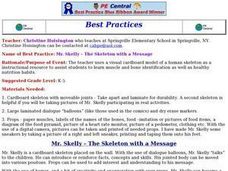Ask a Biologist
Human Skeleton Anatomy Activity
Young biologists piece together the puzzle of the human body with this simple anatomy worksheet. Presented with a picture of the human skeleton, students are challenged with the task of correctly identifying the 27...
Curated OER
From Human Skeletons to Owl Pellets to Paleontology
Learners explore about the function of the skeleton and comprehend the names of the bones of the human skeleton. They compare bones of the human skeleton to a dinosaur skeleton and graph to compare these bones. Students sort bones to...
Curated OER
Skeleton
First graders put a skeleton together and draw the main bones in the body. In this skeleton lesson plan, 1st graders learn about the main bones, and draw 8 out of 10 of them correctly.
Curated OER
Moving and Growing
Students explore the types of skeletons in various animals. In this skeletal systems lesson plan, students watch a video clip about skeletons, view a human skeleton, compare the skeletons of humans, chickens and fish, and learn about...
eSkeletons
Matching: Adult, Homo Sapiens
Looking for a basic skeleton-system-matching worksheet? You've found it! Kids color in the skeleton bones with different colors before matching each bone to its correct name. The vocabulary isn't simple here; learners are locating...
Curated OER
How 'bout them bones!
After a lesson on the human skeleton, hand out a learning exercise that requires learners to identify the pelvis, rib cage, skill, spine, and thigh bones. They draw a line from the name of the bone to its location on the skeleton. Tip:...
Curated OER
Health: The Skeleton with a Message
Students identify human muscles and bones from a cardboard skeleton, named "Mr. Skelly." Using dialog balloons as props, the teacher holds up advice from Mr. Skelly, such as noting he drinks milk to keep his bones strong. The lesson...
Project SMART
Dinosaur Trek
Second graders investigate dinosaurs. They explore various websites, submit questions to a paleontologist online, construct cut and paste model dinosaur skeletons, develop a graph to compare dinosaurs, and label pictures from online...
Curated OER
Explore Fish
Read Animals Called Fish with your young Spanish language learners and talk about the different parts of a fish. After teaching terms like huesos, columna vertebral, aletas, escamas, etc, Learners...
Curated OER
All About Birds
In this birds activity, students answer 25 short answer questions about birds. They color and label the different parts of a bird and fill in the correct term given the definitions.
Curated OER
Bones and Muscles
Third graders are introduced to bones as the body's means of support and protection. They research bone facts and conduct an experiment with chicken bones. They identify and observe involuntary muscles at work.
Curated OER
Bones in Your Body
In this bone identification worksheet, students label each bone in the picture with the words provided in the word bank. Students then cut out each bone and fit them together to make a skeleton.
IBM
The Human Body
Every moment, the systems in your body are working together to keep you breathing, standing, and thinking. Elementary schoolers explore the human body and its systems with an impressive, 15-page lesson plan that should leave your...
Curated OER
Bones Provide Great Support!
How do bones help people move around? A science investigation prompts kids to draw arrows to certain bones that protect their organs. After they finish, they trace their hands on a piece of paper and trace the way their bones go. Great...
Curated OER
Bite on This!
Different types of teeth have different roles. Third graders study how molars, incisors, and canines function in a rabbit skull and a cat skull. After answering some questions about the teeth of herbivores and carnivores, kids...
Curated OER
Mollusk Matching
Students look carefully at shells and observe the differences between
species and the names of common shells. Then they identify and complete a Mollusk Matching handout included in the lesson and write the letter of each shell in the...















